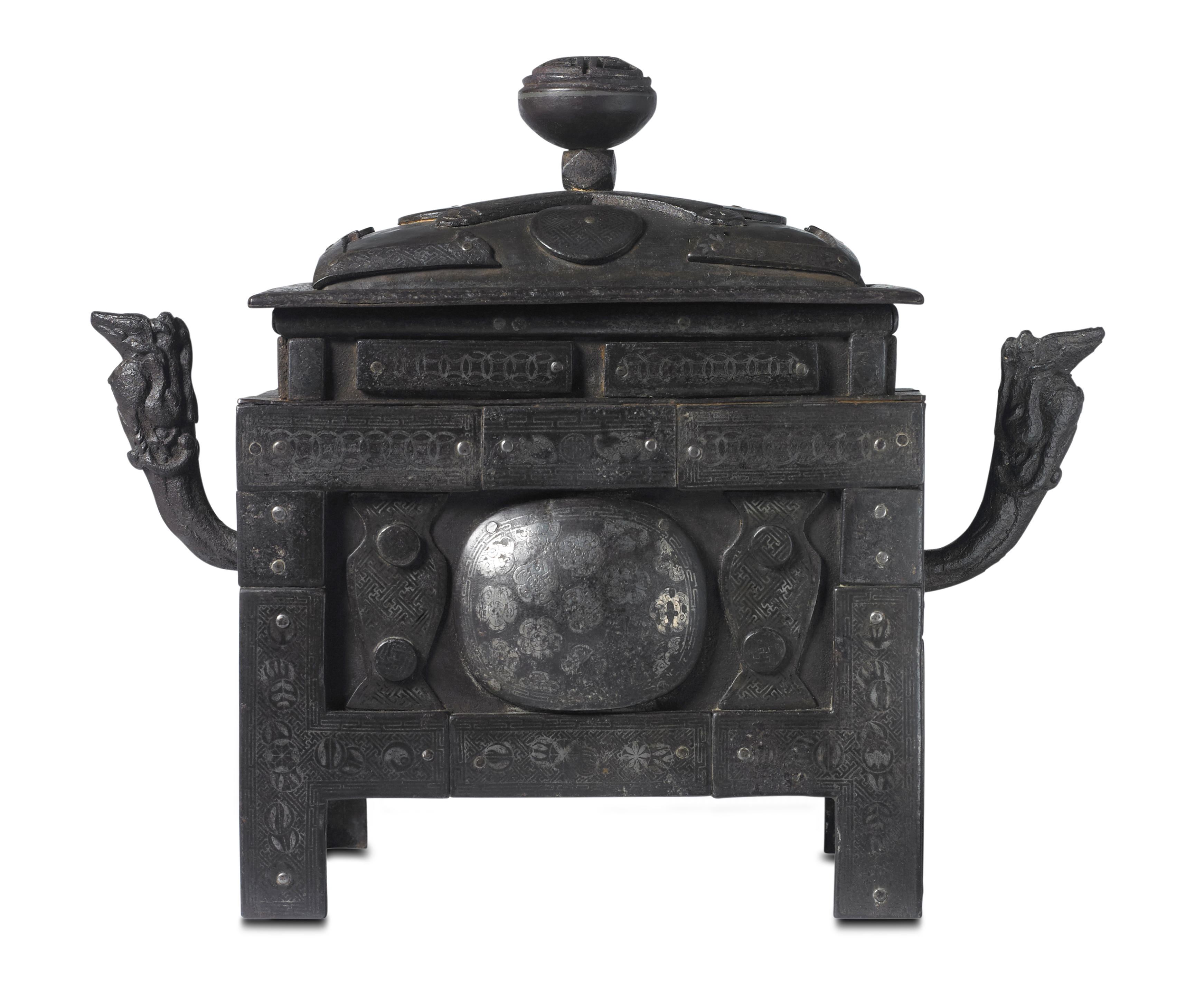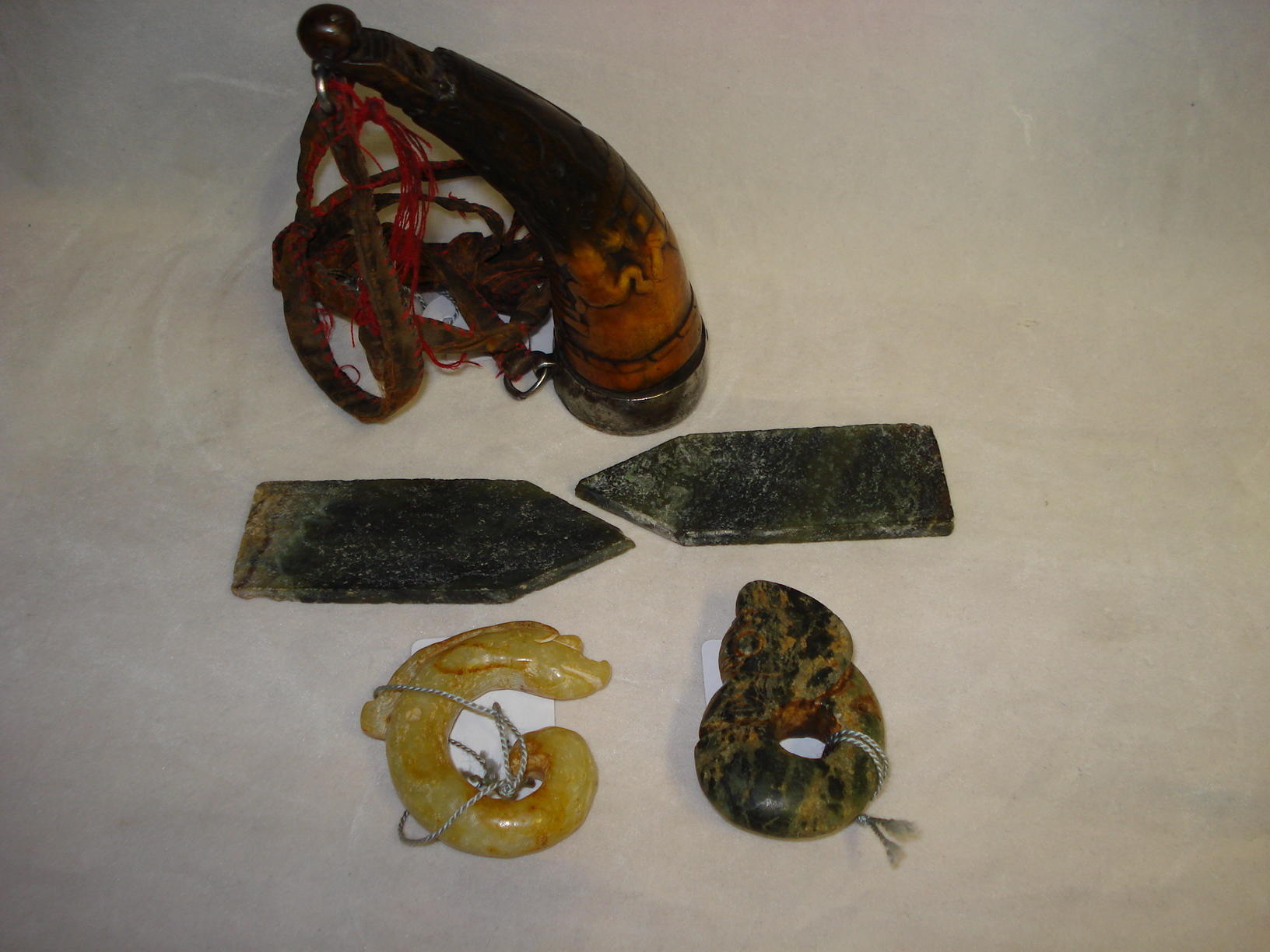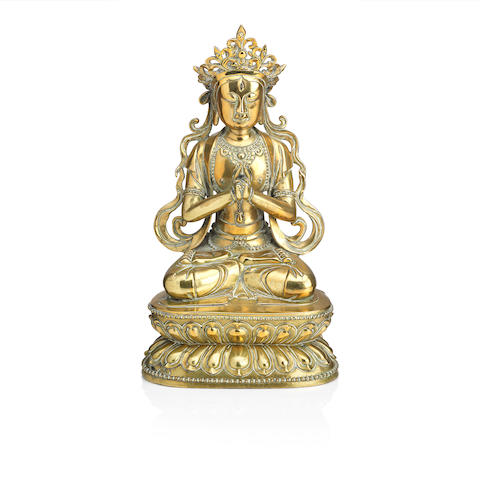An unusual Sino-Tibetan Thangka of Milarepa, 18th century, the yogi seated in a relaxed pose, surrounded by Gampopa and Rechungpa, the fierce hunter Chirawa Gumbo Dorje and his bitch chasing a frightened deer, the Goddess of the Mountain Tseringma, the demonic forces of the mind, Heruka Chakrasmvara and Vajrayogini, all set within a mountainous landscape, with waterfalls and clouds, mineral pigments on silk woven with patterns of dragons amid scrolling clouds, 127 x 86 cm 西藏十八世纪 密勒日巴唐卡 Provenance: Private European collection. Monumental in size, this thangka is one of the finest products of the Karma Gardri Painting School of Eastern Tibet, presenting a naturalistic setting of sublime beauty, tranquillity, and ecstatic clarity of vision for the enlightened yogi, which resulted from the influence of Chinese stylistic conventions. Milarepa is one of the most celebrated figures of Tibetan Buddhism. Living during the 11th and 12th centuries as ordinary Tibetan, he was orphaned young and learnt black magic to revenge the deprivation of inheritance caused by his immediate relatives. Repentant, he retired in the Himalayas Mountains where he turned to the study of Tantric Buddhism and achieved enlightenment under the teachings of the of the great Master, Marpa. Thus, he became one of the leading figures of the Kagyu School. Much of the known information about Milarepa is known through the stories he sang whilst on retreat in the mountains, dealing with his hermitages, encounters, renunciations, and contentment. Some of these stories form the subject matter of this thangka and so vividly express Milarepa’s fundamental teachings of confronting the evil forces as the only way to strengthen one’s spiritual progress towards enlightenment. Seated with his hand cupped to his hear as if listening to the long tongue of the Dharma, the yogi has clearly experienced the state beyond striving, having envisioned the Buddha’s manifestations of Vajayogini and Heruka Chakrasamvara. Vajrayogini, the enlightened energy, transforms wordly passions into luminuous awareness, having severed the roots of all mental illusions and bringing all actions into luminuous fruition; she holds a knife in her right hand, in the other hand, a skull cup filled with blood, the essence of the life force, and a Tantric staff symbolising the awakening of bliss. Heruka Chakrasamvara, the great bliss of inner transformation, appear with his consort, embodying the liberation from ignorance and the union of wisdom and compassion. These mental companions surely helped the yogi to battle the evil presences, presented on the upper right part, which he appears to tame. The conversion of the hunter, initially fierce chasing a ravening deer and then eased by the serene presence of Milarepa, is a popular story of the Milarepa’s lore. Tseringma, Goddess of the Mountain and Long Life, praised by Milarepa for her capacity to give the energy of longevity and initiating the glory of enlightenment, is also overwhelmed by the resolve of Milarepa and presents him with a tribute of flowers and drink. Clearly, the use of blue and green rocks, towering peaks, misty clouds, conveying the grandeur of nature, and the receding planes, decreasing figures and overlapping motifs, conveying the illusion of depth, were familiar to the Chinese painting tradition. Several scholars have identified in the Indian depictions of the Arhats, Buddhist adepts that followed the Buddha and taught on earth, penetrated in both Tibet and China, the influence determining the landscape format within which to present holy figures in later centuries. In China, these conventions well adapted to the presentation of immortal beings and lands, and were perfected throughout the centuries to becoming associated with the scholarly seclusion from the turmoil of political affairs. Indeed, the Tibetans acknowledged fine Chinese art modes throughout the numerous visits to the Chinese court or in form of tributes sent to religious lead
An unusual Sino-Tibetan Thangka of Milarepa, 18th century, the yogi seated in a relaxed pose, surrounded by Gampopa and Rechungpa, the fierce hunter Chirawa Gumbo Dorje and his bitch chasing a frightened deer, the Goddess of the Mountain Tseringma, the demonic forces of the mind, Heruka Chakrasmvara and Vajrayogini, all set within a mountainous landscape, with waterfalls and clouds, mineral pigments on silk woven with patterns of dragons amid scrolling clouds, 127 x 86 cm 西藏十八世纪 密勒日巴唐卡 Provenance: Private European collection. Monumental in size, this thangka is one of the finest products of the Karma Gardri Painting School of Eastern Tibet, presenting a naturalistic setting of sublime beauty, tranquillity, and ecstatic clarity of vision for the enlightened yogi, which resulted from the influence of Chinese stylistic conventions. Milarepa is one of the most celebrated figures of Tibetan Buddhism. Living during the 11th and 12th centuries as ordinary Tibetan, he was orphaned young and learnt black magic to revenge the deprivation of inheritance caused by his immediate relatives. Repentant, he retired in the Himalayas Mountains where he turned to the study of Tantric Buddhism and achieved enlightenment under the teachings of the of the great Master, Marpa. Thus, he became one of the leading figures of the Kagyu School. Much of the known information about Milarepa is known through the stories he sang whilst on retreat in the mountains, dealing with his hermitages, encounters, renunciations, and contentment. Some of these stories form the subject matter of this thangka and so vividly express Milarepa’s fundamental teachings of confronting the evil forces as the only way to strengthen one’s spiritual progress towards enlightenment. Seated with his hand cupped to his hear as if listening to the long tongue of the Dharma, the yogi has clearly experienced the state beyond striving, having envisioned the Buddha’s manifestations of Vajayogini and Heruka Chakrasamvara. Vajrayogini, the enlightened energy, transforms wordly passions into luminuous awareness, having severed the roots of all mental illusions and bringing all actions into luminuous fruition; she holds a knife in her right hand, in the other hand, a skull cup filled with blood, the essence of the life force, and a Tantric staff symbolising the awakening of bliss. Heruka Chakrasamvara, the great bliss of inner transformation, appear with his consort, embodying the liberation from ignorance and the union of wisdom and compassion. These mental companions surely helped the yogi to battle the evil presences, presented on the upper right part, which he appears to tame. The conversion of the hunter, initially fierce chasing a ravening deer and then eased by the serene presence of Milarepa, is a popular story of the Milarepa’s lore. Tseringma, Goddess of the Mountain and Long Life, praised by Milarepa for her capacity to give the energy of longevity and initiating the glory of enlightenment, is also overwhelmed by the resolve of Milarepa and presents him with a tribute of flowers and drink. Clearly, the use of blue and green rocks, towering peaks, misty clouds, conveying the grandeur of nature, and the receding planes, decreasing figures and overlapping motifs, conveying the illusion of depth, were familiar to the Chinese painting tradition. Several scholars have identified in the Indian depictions of the Arhats, Buddhist adepts that followed the Buddha and taught on earth, penetrated in both Tibet and China, the influence determining the landscape format within which to present holy figures in later centuries. In China, these conventions well adapted to the presentation of immortal beings and lands, and were perfected throughout the centuries to becoming associated with the scholarly seclusion from the turmoil of political affairs. Indeed, the Tibetans acknowledged fine Chinese art modes throughout the numerous visits to the Chinese court or in form of tributes sent to religious lead














Testen Sie LotSearch und seine Premium-Features 7 Tage - ohne Kosten!
Lassen Sie sich automatisch über neue Objekte in kommenden Auktionen benachrichtigen.
Suchauftrag anlegen